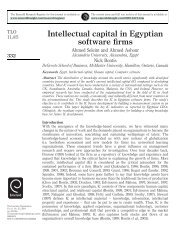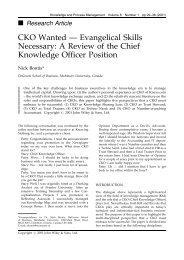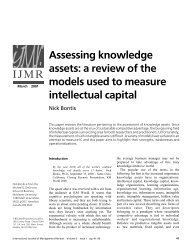A scientometric analysis of knowledge management and ... - Emerald
A scientometric analysis of knowledge management and ... - Emerald
A scientometric analysis of knowledge management and ... - Emerald
Create successful ePaper yourself
Turn your PDF publications into a flip-book with our unique Google optimized e-Paper software.
Table I List <strong>of</strong> KM/IC peer-reviewed journals<br />
Journal title Issues analyzed Number <strong>of</strong> articles<br />
Electronic Journal <strong>of</strong> Knowledge Management Vol. 1 No. 1, 2003-Vol. 6 No. 1, 2008 135<br />
International Journal <strong>of</strong> Knowledge <strong>and</strong> Learning Vol. 1 Nos 1/2, 2005-Vol. 4 No. 5, 2008 109<br />
International Journal <strong>of</strong> Knowledge Management Vol. 1 No. 1, 2005-Vol. 4 No. 2, 2008 73<br />
International Journal <strong>of</strong> Knowledge Management Studies Vol. 1 Nos 1/2, 2006-Vol. 2 No. 3, 2008 52<br />
International Journal <strong>of</strong> Learning <strong>and</strong> Intellectual Capital Vol. 1 No. 1, 2004-Vol. 5 No. 2, 2008 121<br />
Journal <strong>of</strong> Intellectual Capital Vol. 1 No. 1, 2000-Vol. 9 No. 2, 2008 270<br />
Journal <strong>of</strong> Knowledge Management Vol. 1 No. 1, 1997-Vol. 12 No. 3, 2008 482<br />
Journal <strong>of</strong> Knowledge Management Practice Vol. 1 No. 1, 1998-Vol. 9 No. 2, 2008 151<br />
Knowledge <strong>and</strong> Process Management Vol. 4 No. 1, 1997-Vol. 15 No. 2, 2008 293<br />
Knowledge Management Research <strong>and</strong> Practice Vol. 1 No. 1, 2003-Vol 6 No. 2, 2008 127<br />
The Learning Organization Vol. 1 No. 1, 1994-Vol. 15 No. 3, 2008 362<br />
Total 1994-2008 2,175<br />
conversations, <strong>and</strong> book reviews were excluded. For each article, the following variables<br />
were collected: journal’s name, year, volume, issue, title, list <strong>of</strong> authors, their affiliations, their<br />
countries <strong>of</strong> residence, <strong>and</strong> total number <strong>of</strong> authors. When two affiliations were mentioned<br />
the first one was used, since it was assumed that authors tend to list their more relevant<br />
affiliation first. Article title, volume <strong>and</strong> issue were not used in the <strong>analysis</strong> <strong>and</strong> retained only<br />
to avoid duplicate entries. After the dataset was developed, it was pro<strong>of</strong>read by two<br />
independent researchers, <strong>and</strong> minor mistakes were fixed.<br />
The selected publications represent over 70 percent <strong>of</strong> the body <strong>of</strong> <strong>knowledge</strong> existing in<br />
KM/IC-specific outlets, <strong>and</strong> an <strong>analysis</strong> <strong>of</strong> this set <strong>of</strong> articles may produce results<br />
generalizable to KM/IC research in general.<br />
Recall that there are at least four distinct approaches that may be utilized to calculate<br />
productivity scores:<br />
1. normalized page size;<br />
2. author position;<br />
3. direct count; <strong>and</strong><br />
4. equal credit.<br />
To answer RQ1, RQ2 <strong>and</strong> RQ3, lists <strong>of</strong> the 30 most productive countries, institutions <strong>and</strong><br />
individuals were constructed. For this, the equal credit technique was selected to report all<br />
productivity scores.<br />
To answer RQ4, the direct count <strong>and</strong> author position techniques were used to measure<br />
productivity. The scores obtained by these methods, however, are not presented in this<br />
study; they were only used to calculate correlation coefficients among the three methods<br />
(i.e. author position, direct count, <strong>and</strong> equal credit).<br />
To test Lotka’s law (RQ5), numbers <strong>of</strong> individuals who published, one, two, three, four, etc.<br />
papers were calculated <strong>and</strong> compared to theoretical frequencies predicted by Lotka’s law.<br />
The goal is to find the most optimal value <strong>of</strong> n that would fit the observed publication<br />
patterns. Lotka initially suggested that n ¼ 2; different values, however, were <strong>of</strong>ten obtained,<br />
from 1.5 to 3 (Bonnevie, 2003), from 1.95 to 3.26 (Chung <strong>and</strong> Cox, 1990), <strong>and</strong> from 2.21 to<br />
2.46 (Cocosila et al., 2009). Specifically, n ¼ 2:7 was suggested for a specific KM/IC<br />
conference (McMaster World Congress) (Serenko et al., 2009). Therefore, similar to previous<br />
projects (Newby et al., 2003; Rowl<strong>and</strong>s, 2005), a number <strong>of</strong> different values <strong>of</strong> n were used to<br />
optimize the distribution <strong>and</strong> to minimize aggregated errors that were calculated as sums <strong>of</strong><br />
squared differences between predicted <strong>and</strong> observed numbers. The C coefficient<br />
corresponded to the number <strong>of</strong> individuals who published only one paper.<br />
To investigate research methods employed by KM/IC scholars (RQ6), a classification<br />
scheme presented by Serenko et al. (2009) was utilized. This approach is based on a<br />
VOL. 14 NO. 1 2010 j JOURNAL OF KNOWLEDGE MANAGEMENT j PAGE 9








